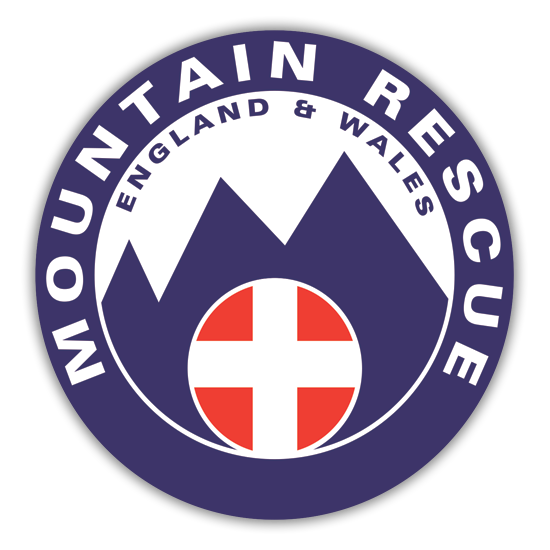Fact File 2: Our history
Coniston Fells Rescue Party in action © Daily Post archive 1947
From climbing clubs to world-class service: how mountain rescue grew up
Until the late eighteenth century, when a new generation of writers and artists began to inspire adventure in the hills, walking and climbing for fun were the prerogative of the rich. The farmers, shepherds, road builders and quarrymen were there from necessity, not for pleasure. The injured either died at the scene of their misfortune or relied on ad hoc rescue parties, hastily assembled and using makeshift equipment, and possibly died anyway, their injuries made all the worse by the journey across rough terrain.
The leader does not fall
Tradition was ‘the leader did not fall’ and they knew the risks. In 1903, a tragic accident high on Scafell Pinnacle – the worst British climbing history had known – saw four climbers, tied together as they climbed, fall together to their death as their leader slipped. The ‘Scafell Disaster’ was a pivotal moment in mountain rescue history as a shocked climbing fraternity began to consider the increasing incidence of mountain accidents and the lack of rescue resources available. Within a year, rudimentary first aid and mountain rescue equipment began to appear in key areas. But it was an accident in 1928, in the Peak District, and the extreme difficulties encountered by rescuers, which sparked the eventual formation of the Mountain Rescue Committee.
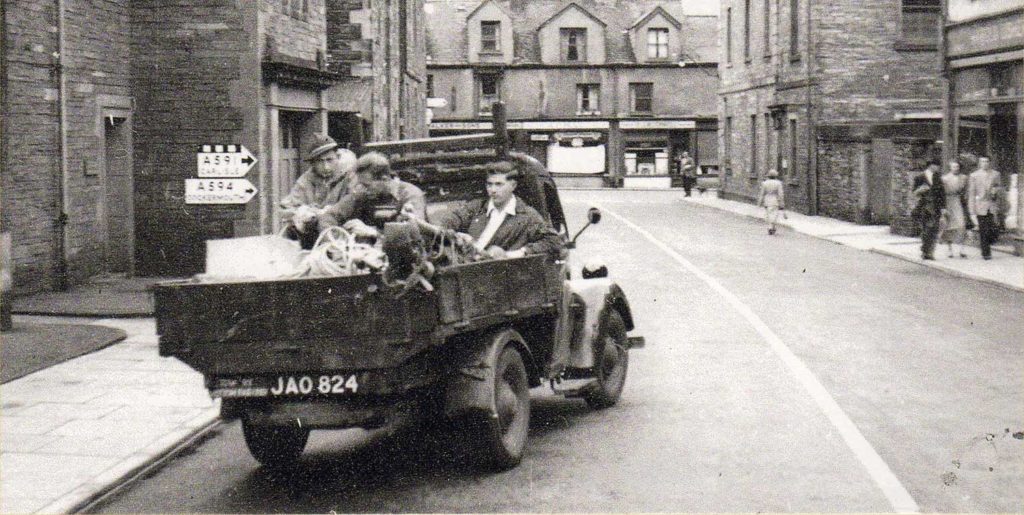
The accident occurred on a Rucksack Club meet in November when Edgar Pryor was knocked off the upper stance on the Long Climb at Laddow by a lady climber falling down the upper pitch. He fell about 40 feet into an adjacent gully, breaking his skull and thigh bone. Relays of runners brought up supplies of warm blankets and hot water bottles, a splint was devised from a rucksack frame, and the finger post from the Crowden path formed a makeshift stretcher. But, nevertheless, it was an agonising business. The nearest place on the road to which the ambulance could be taken involved carrying the patient for four hours, using relays of stretcher bearers. And, on reaching the ambulance, Pryor faced a further one and a half hour journey to hospital, at the Manchester Royal Infirmary.
Delivered to the Infirmary, he came under the care of Wilson Hey, consulting surgeon, who later observed that the casualty was so shocked he needed blood transfusion before he could be operated on, and that the transport and shock had so damaged the limb, he was forced to amputate some months later. ‘The absence of morphia with the transport had done more damage to the limb than the mountain,’ he said.
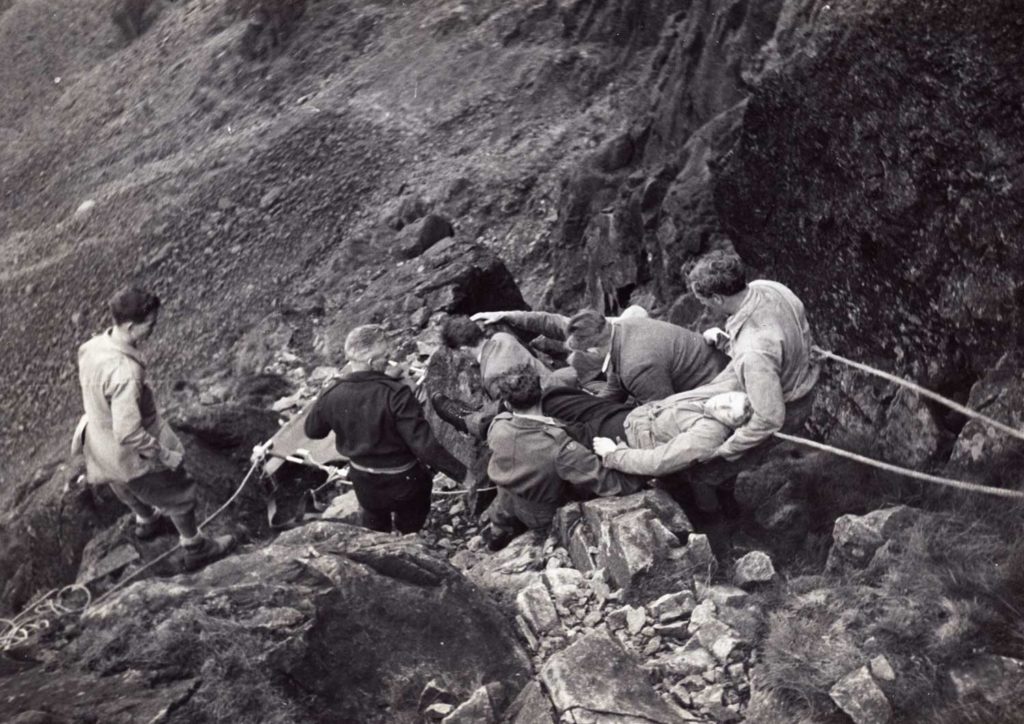
Searching for a mountain rescue stretcher
Meanwhile, in 1932 the Rucksack Club and the Fell and Rock Climbing Club combined to form the Joint Stretcher Committee, charged to produce a suitable mountain stretcher and a list of first aid equipment. The Thomas stretcher was deemed the most suitable as the design allowed the end carriers to see their feet and avoid stumbling, and the wooden runners gave sufficient ground clearance to allow easy movement across rock, scree, grass or snow. Along with a double Thomas splint, wooden arm splints, iodine, bandages, kettle, primus stove, an eiderdown, feeding cup and urine bottle, the new stretchers were to be left at designated posts for use as required. Posts were established in the popular climbing areas, managed by the clubs with the help of donated funds and under the supervision of a designated individual.
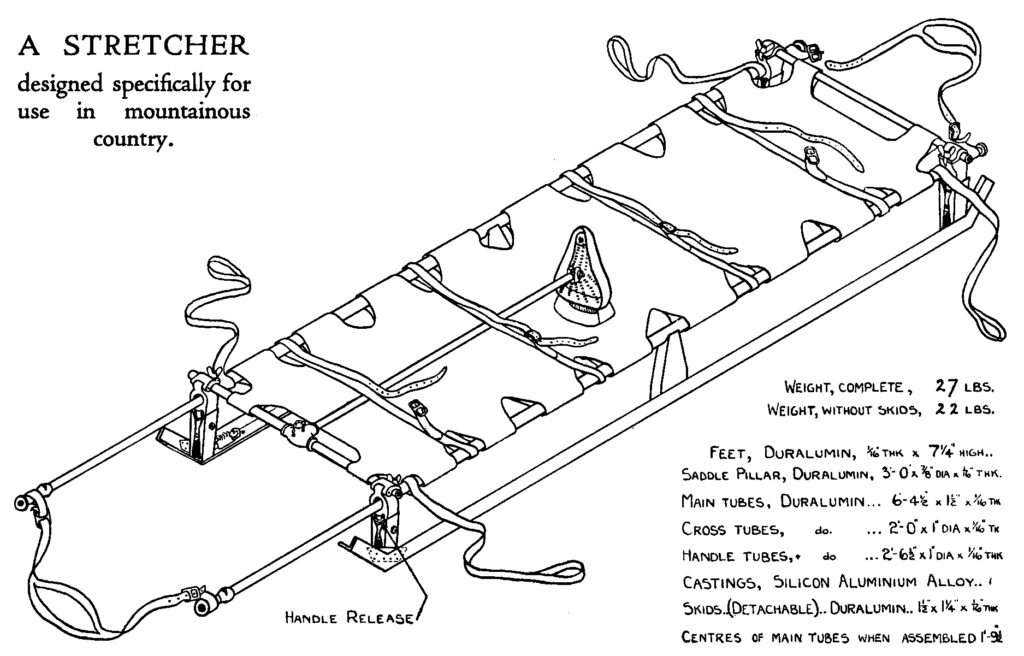
In 1936, the committee decided a more permanent structure was called for and the First Aid Committee of Mountaineering Clubs was created from representatives of the clubs, including those of the universities, and bodies with allied interests such as the Ramblers Federation and the Youth Hostel Association. A central fund was organised from a 2% levy from the clubs and all accidents and use of equipment had to be reported to the committee.
It was Wilson Hey’s determined belief in the use of morphia – and its eventual addition to the equipment list – which many consider his most powerful legacy to mountain rescue. It was fifteen years before he could persuade Whitehall that ‘morphia reduces suffering, and suffering produces shock, and prolonged shock causes death’ but, so convinced was he in the benefits to the casualty, that he issued morphia to the posts without a licence, at his own expense.
In 1949, the government relented and agreed to the supply of three quarter grain ampoules for each post, except for Ogwen and Glencoe which would have six ampoules each, due to the frequency of accidents in those areas. Since that day, mountain rescue has appointed a Medical Officer responsible for the issue of morphia.
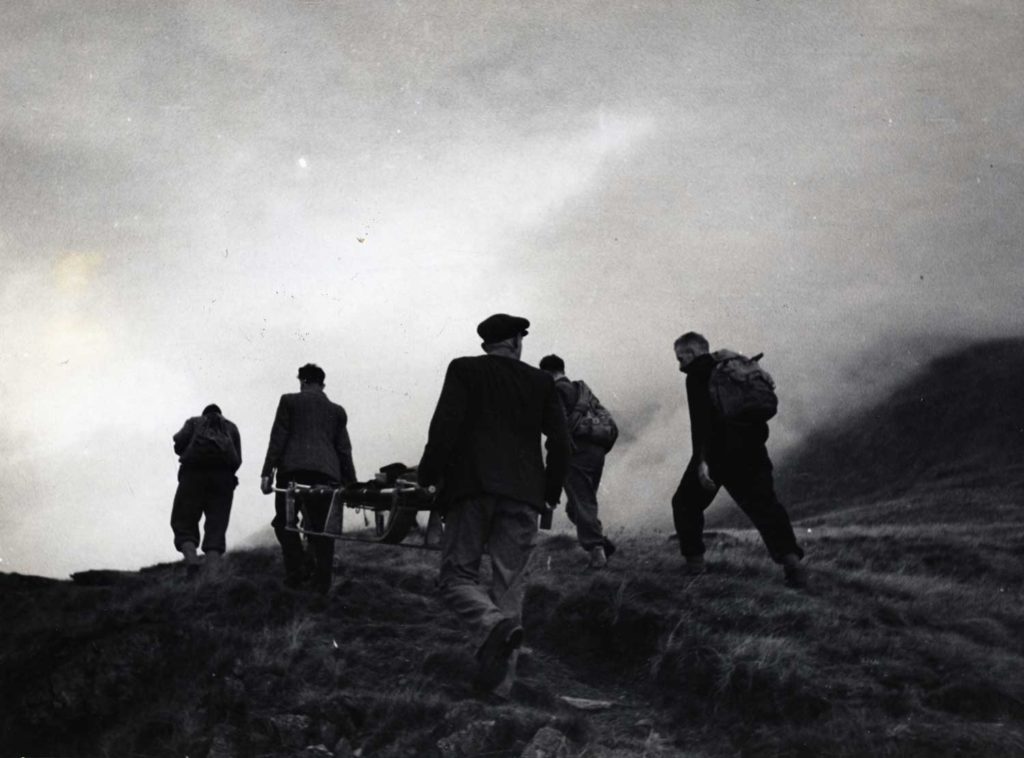
The first civilian mountain rescue teams take shape
By 1950, the First Aid Committee of Mountaineering Clubs had become the Mountain Rescue Committee (MRC), a charitable trust with membership from a far wider spectrum of outdoor pursuit groups. It was events in Coniston and Keswick which prompted the formation of the first civilian mountain rescue teams. Similar stirrings were occurring in the mountains of Scotland and North Wales — where the RAF mountain rescue service, initially conceived for the rescue of air crew downed in the mountains, was increasingly involved in the rescue of civilians.
In late December 1946, Ernest John Harris Sivyer set off across the fells but failed to return. At first light, a rapidly assembled party of local people set out to search the area around Dow Crags and Coniston Old Man to no avail. By next morning, fifty policemen had joined farmers and other volunteers to search over a hundred square miles of countryside in the most appalling conditions. Sivyer’s body was found just 500 foot from the main road, where he appeared to have fallen about 400 foot down a steep gully. The search had taken such a toll on those involved that the first civilian mountain rescue team in England was formed, led by Jim Cameron.
Over in Keswick, an accident on Great Gable in April 1946 prompted the formation of the Borrowdale MRT (now Keswick MRT) under the leadership of Rusty Westmorland. Two experienced climbers had been tackling a climb called Shark’s Fin when a gust of wind blew one of the men from his sloping hold. He fell onto a ledge, his femur broken. Their subsequent rescue was a long and laborious twenty one hours, much of it endured without food, in foul weather and darkness — exhausting for everyone involved.
Across the UK, and over the years, a variety of accidents, searches and light aircraft crashes in mountainous and moorland areas galvanised the locals into action. Initially, there was little direct communication between teams, just the six monthly meetings at Hey’s rooms in St John Street, Manchester. And yet, new teams continued to spring up with similar values, similar aspirations, each subtly adapted to their own environment.
1960 saw the creation of a Scottish subcommittee, initially led by Dr Donald Duff, to deal with the day-to-day problems of administering a mountain rescue service north of the Border. It was the first step towards a separate Scottish mountain rescue service and, in June 1965, the Mountain Rescue Committee of Scotland was formed.
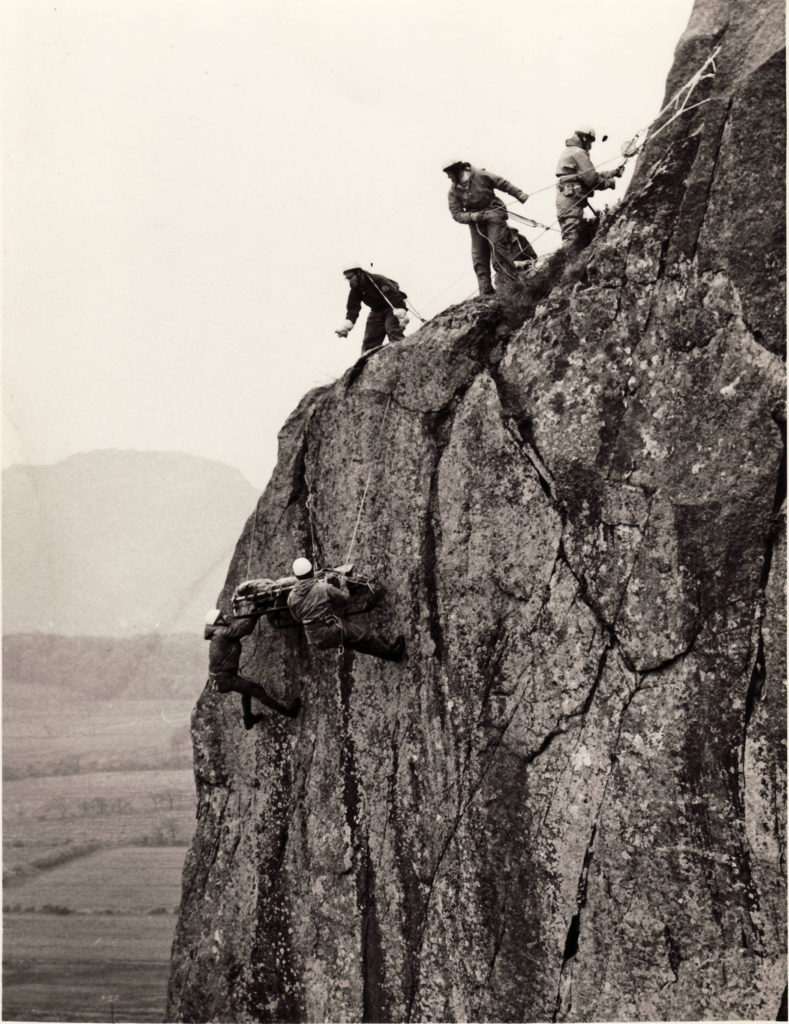
The work continues
Teams in England and Wales have continued to work together, both at local level and through the national body – now known as Mountain Rescue England and Wales. Where once operational territories and regional differences were often fiercely guarded, in recent years, multi-team cooperation has become a significant feature of mountain rescue. The ability – and necessity – of teams working together, sharing experience, manpower, technology and resources first became clear in October 2012, when five-year-old April Jones was abducted from near her home in the quiet mid-Wales market town of Machynlleth.
Initially, the search involved just local police officers and members of the Aberdyfi and Brecon teams, along with many members of the local community. But it quickly became evident that this incident was much bigger than first anticipated, local resources alone would be stretched to breaking point. And so began one of the largest search and rescue operations in the UK for over twenty years, involving many services, agencies and members of 23 mountain and cave rescue teams. As the circle of involvement grew ever wider, first neighbouring teams joined the search, then their neighbours. Further afield, other teams provided cover for those who’d left their own patches to travel to Wales.
By the end of the search, Brecon search managers identified that the search area had covered 72.26km square, with 208 search areas of median size 0.26km square. There were 1,075 ‘searcher days’ given, with approx 13,400 hours of time. More than 6,000 SARCALL SMS messages were sent supporting the operation, with 2,670 sent on the Saturday of the search.
The incident demonstrated that teams could and would work together, that there was a commonality of ethos and standards which should be harnessed and systems created in readiness for future such emergencies.
Three years later, in December 2015, mountain rescue’s interoperability was put to the test once again, when first Cumbria, then York, North Wales and areas in Salford and Lancashire (far from the mountains) succumbed to devastating flooding.
Previously, when flooding hit a team’s area, response tended to be local as team members turning out to help where they could in their local communities. But there was a level of frustration at not being fully equipped and trained to deal with such incidents. Gradually, the idea of swiftwater and bankside water training took hold, with team members equipped and trained to search alongside and through water. Then, in 2014, the Lake District teams drafted a regional Major Incident Plan and set about training in Water and Flood Incident Management. ‘Exercise Cloudburst’ followed. Many thought the scenario over the top at the time but this regional table-top exercise, based on a fictitious flood of the small town of Egremont and the surrounding area, doubtless proved invaluable in December 2015.
Over fourteen days of flooding, national calls for help were met by the combined efforts of 32 individual teams travelling into the affected areas to assist their fellow mountain rescue colleagues and the communities they support.
In Cumbria, as the rivers rose, jobs came from the police to MR Bronze, then out to teams via Airwave radio and team members were involved in a wide range of tasks helping recover people, pets and possessions. The local teams were busy in Cockermouth, Keswick and Kendal. Penrith team members attended a number of incidents in Eamont Bridge, Kirkby Stephen helped with evacuations in Appleby and Patterdale team members, driven from their own base by floodwater, helped with the rescue of an Ullswater steamer that had broken free from its moorings. Duddon and Furness team helped to move kidney dialysis patients in the south of the county.
With the local teams busy on home ground, a number of out-of-county teams were important to the rescue effort in Carlisle. Groups from the Peak District, Calder Valley, Ogwen, NEWSAR, Kirkby Stephen, Penrith and Wasdale were all deployed in the town. Bowland Pennine MRT and CRO also supported in south Cumbria.
Three weeks later, the waters rose again. This time the focus was on North Wales, Lancashire, Salford, West Yorkshire and York. And once again teams from across England and Wales – including a 52-strong contingent from the Devon teams – joined forces to help the stricken communities. Once again, Land Rovers emblazoned with names and logos more usually associated with their local habitats, were out and about hundreds of miles from their homes, in the name of ‘mountain rescue’. Together they helped to safely clear hundreds of houses and deserted cars, evacuated people, families, dogs, parrots and assorted pets to recovery centres, delivered nurses and medications to house-bound patients and completed numerous other tasks. A total of 14,808 hours were attributed to the 32 teams who worked on flood-related incidents covering those fourteen days. And all the while, their colleagues back home were busy providing cover for the ‘bread and butter’ work of mountain rescue.
Royal connections
In May 2007, we were honoured to appoint HRH The Duke of Cambridge as our patron. Since then, through this royal connection, mountain rescue has regularly collaborated with some of the other charities in the Princes’ Charities Forum, a group which brings together those under the patronage of both Prince William and Harry and also, Catherine, the Duchess of Cambridge.
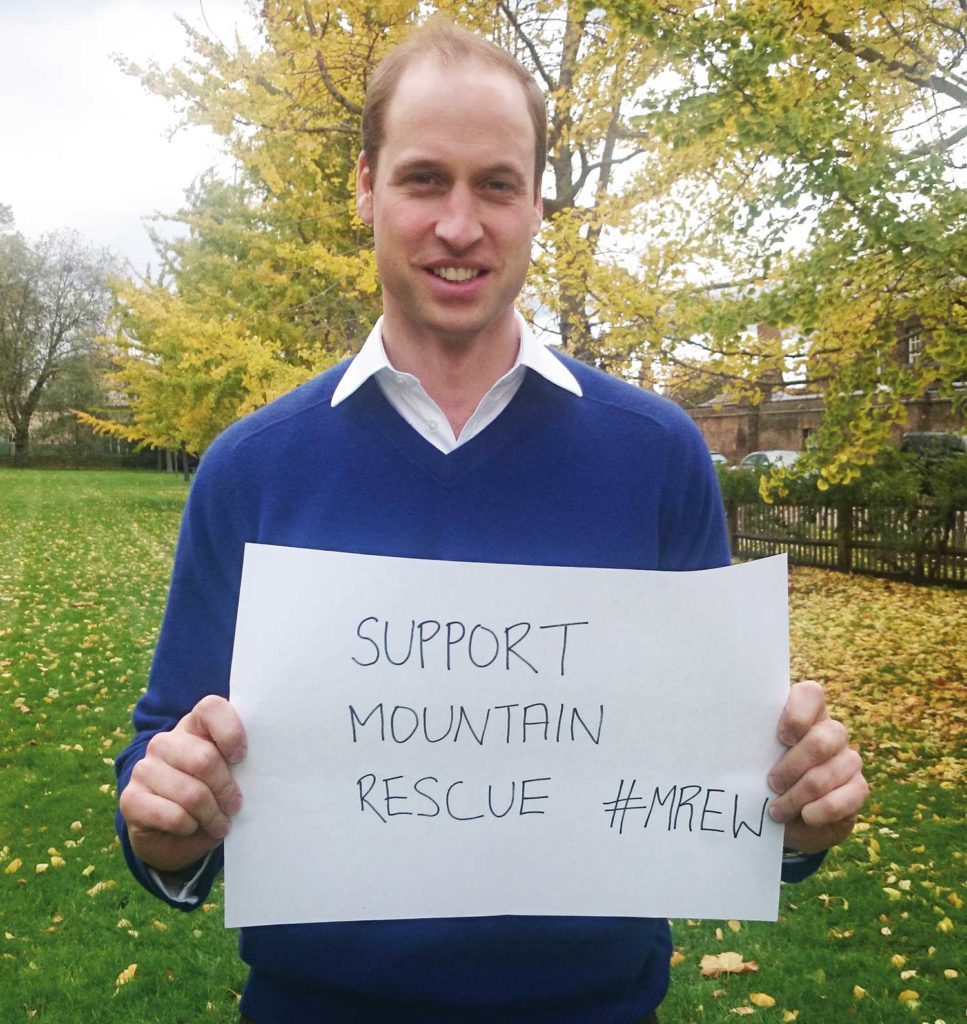
This collaboration has seen an annual event, hosted by a different region each year, in which children and young people and their families, who are disadvantaged through ill health, bereavement or homelessness, are entertained for a day in the mountains.
And, of course, for three years, William himself was often heard across the airwaves in North Wales, in his capacity as helicopter pilot at RAF Valley, on Anglesey.
Change and growth
Over the years, the growth in mountain rescue teams took its toll on the rescue post system and, in 1989, Ordnance Survey reversed their landmark decision to show rescue posts on their maps.
The search for the ‘perfect’ mountain stretcher continues to drive a dedicated few. Other equipment developed with the mountain casualty in mind includes the ‘casbag’, the vacuum mattress and the Little Dragon warm air breather. But perhaps the greatest development has been the growth in satellite and mobile phone technology which has hugely advanced the communication capability of teams and casualties. It’s hard to imagine that once the only way to summon help was to run as fast as possible to the nearest hotel or youth hostel. And even then there was rarely a phone line at the foot of the mountain. Nowadays, thanks to GPS, smartphone technology and the work of a number of mountain rescue team members, times have changed.
With the SARLOC app, developed by Russ Hore, not only can the casualty party call for help from where they are (given a mobile signal) but teams can often pinpoint exactly where a casualty is too, thus ensuring the best use of resources and saving valuable time.
From the point of view of organising call-outs and recording ongoing activity, SARCALL, developed by John Hulse, has proved its worth, especially during multi-team incidents. And MRMap, developed by Rob Brookes, David Binks and Russ Hore, enables teams to plot the movements of their members during call-outs and training.
In 2018/19, Mountain Rescue England and Wales began the long process of changing its status to a Charitable Incorporated Organisation (CIO) with a new charity number: 1178090. The CIO finally became fully operational in January 2020.
We’ve come a long way since those early years of hob-nailed boots and cobbled-together kit!
Related pages
Share This Page
Keep in touch
If you'd like to keep in touch, why not subscribe to our mailing list?
By signing up, you accept the terms of Mountain Rescue England and Wale’s Privacy Policy and consent to receive our emails with access to our latest news and events. You can unsubscribe at any time.
